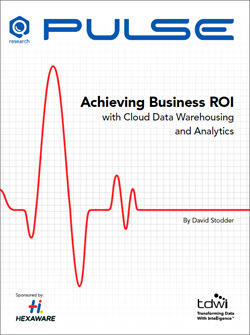
TDWI Pulse Report | Achieving Business ROI with Cloud Data Warehousing and Analytics
December 20, 2019
Organizations are shifting to the cloud for business advantage.
Data management and analytics are in the midst of a sea change as organizations adopt cloud-based services to augment or replace existing on-premises systems. Although data security remains a top priority, more organizations are satisfied that security in the cloud is dependable and that they can move ahead with migrations.
The focus today is less on justifying the move to the cloud and more on how to get there faster and with less difficulty—and once in the cloud, how to manage data and analytics so organizations can realize greater business value and return on investment (ROI) than they could with strictly on-premises systems.
The cloud can play a big role in freeing organizations from the physical and economic constraints imposed by on-premises systems as well as legacy practices that have been shaped by constraints on volume, data variety, speed, scalability, and compute power. Cloud-based data platforms, storage, and analytics offer organizations opportunities to support new data-driven projects that may be too difficult, expensive, or slow to develop with existing systems.
This TDWI Pulse Report examines five areas that organizations need to address to ensure business value and ROI as they increase the role of the cloud in data life cycles.